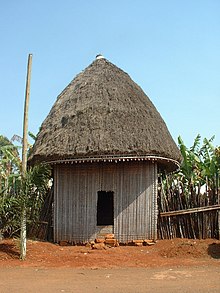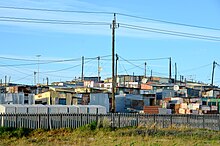hut
A hut is a comparatively small and structurally simple building that is often built by the later users themselves using locally available, perishable or loosely assembled materials. These properties are used to distinguish it from the larger, higher-quality and usually more durable house .
Occurrence
Europe
In Europe, in particular, simple buildings that were constructed using wood or other lightweight construction (e.g. corrugated iron ) are referred to as huts. Buildings in massive construction (stone, concrete) are rarely referred to as huts.
Huts can be used for short-term stays (shelter, refuge), temporary permanent residence ( apartment ) or for storing objects (e.g. bories , beehive huts ). Depending on the function and context, other names are also used for huts, such as Bude (sales booth ) or shed (tool shed).
Terms derived from the word "hut" that go beyond this description and designate a larger building or a place of work are, for example, " alpine hut ", " ski hut ", " building hut ", " iron hut ", " glass hut " and in some places also " salt hut " .
A resident of a hut in terms of tax law was born in the 17th – 19th centuries. Century referred to as Hüttler . He was not a farmer in the strict sense.
Africa, Central America, Southeast Asia
From a European point of view, human dwellings built from simple materials but definitely designed for the long term are called “huts” in many parts of the world. Such traditional dwellings can still be found today mainly near the equator , i.e. H. in Central Africa, Central America (e.g. Maya hut ) or on many islands in Southeast Asia.
etymology

The word hut has been used in German since the 9th century, in Old High German still as hutta . From the accepted Indo-European word root * hud- in the sense of “protection”, house , skin as well as hats , hats , care should be derived. A connection with * [s] keu- “to cover, envelop” and barn is assumed, also for Kote / Kate mnd. "Hut". The German word has been adopted in more languages than borrowing, for example, in French as cottage , in English as hat . The root of the word can also be found in the Nordic languages (Norw. Hytte "holiday house"). The word koje is also related (originally Latin cavea from nl. Kooi "cage, shed, stable", Swedish koja , norw. Koie but each "hut")
In the original meaning a place covered from the weather or a building constructed with simple means was meant as a place of refuge or storage place. Even in Middle High German there is no strict distinction between hut and tent (tentorium) :
"Dô hie ჳ man ûf the greece manege huts tension with sîdînen snüeren hern Hartmuote unde sînen mannen."
Such provisional roofs (sheds) can be found, for example, on the large construction sites of the early and high medieval cathedral construction. Contemporary representations show stonemasons and carpenters under simply tensioned tarpaulins or flight roofs . It was not until the 19th century that the terms “ Bauhütte ” and “ Dombauhütte ” were coined from the original term “hut” .
Miners referred to any non-solid structure above ground as a “hut”. The term carries over to every place where ore has been broken, melted, poured or salt boiled. Compounds such as “ Hüttenwerk ”, “ Eisenhütte ”, “ Glashütte ”, “ Ziegelhütte ”, “ Kalkhütte ”, “ Salpeterhütte ” and the technical term of smelting are derived from this . In the scrubber - Dyer - and Gerber beings : the word gets to that effect unlucky hut , Gerbhütte , washing cabin (as of village community building such as a rustic farm buildings).
Later the word concretized on building in the actual sense, partly close to officina workshops , then synonymous with shed , shed or shack , and this is where the compositions such as “dog house” come from. Grimm also says “we also talk modern about a festival hut, singer's hut, schiesz hut as a building made of boards, even of a larger size”.
The word hut can also be found for an eight-sided roof structure on ships, the ship's hut . Similar to today's construction trailers and construction containers, there is the hydraulic engineering construction hut ship .
The provisional field of meaning is retained, however, and the word hut generally refers to the nomad's dwelling , but also to the permanent living facilities of the semi-nomads , as in the Alpine region as the “alpine hut” of transhumance, or “forest” and “hunting lodge” of forest management. Other names are out of date, such as "felt hut" ( yurt ), "bird hut" of the bird catcher . The “ Tabernacle ” (Hebrew Sukka ), from which the name “ Feast of Tabernacles ” ( Sukkot , Yidd. Sukkes ) is derived, which recalls the exodus of the Israelite people from Egypt, also stands in this context .
Only recently has the connotation “poor dwelling” emerged.
Hut building

- As a hut , Sennerhutte refers to the huts in the mountains, where the shepherds and the Senner survival during the summer, while they take care of the grazing in the mountains on a mountain pasture cattle, as hunting lodges serve hunters as a shelter during multi-day hunting (in contrast to the cabin as permanent place of residence of the district hunter), and analogous to the forest hut for the accommodations and temporary structures in a field (and forest house as the place of duty of the district forester)
- A restaurant is generally referred to as a ski hut , which in a winter sports area directs its offer in particular to skiers and snowboarders.
- A refuge , mountain hut or refuge is located in otherwise undeveloped areas and serves as protection from storms and as an overnight accommodation and base. Today it is mainly built for hikers and mountaineers.
- A tabernacle is a simple hut that is covered with leaves, branches, etc., especially a temporary hut built on the occasion of the Jewish tabernacle festival .
- So-called arbors v. a. in allotments . Typologically, however, these are mostly closed huts and not open gazebos. They are used for short-term, temporary stays and as a tool shed.
- So-called Nissen huts are the huts made of corrugated iron, designed by the Canadian engineer PN Nissen as early as 1916 as emergency shelters. They are produced in prefabricated construction. A significant feature is the characteristic semicircular roof.
- Slum hut or hut in an informal slum settlement : makeshift building for residential purposes, often made from garbage and residual materials.
- Hut in an alternative hut village : As a civil society protest against building projects, protest camps arise again and again , which often consist of makeshift huts and are usually referred to as hut villages.
- Finnhütte : garden or holiday house in the form of a small roof-top house
- Sauna hut: free-standing sauna , usually built as a wooden hut
- Dog house: man-made dwelling for a house or farm dog as a place to sleep, retreat and rest. In contrast to a dog kennel , it is not used to lock the dog in and keep it.
- Duck huts (from duck, stoop) are simple wooden huts that were built by lumberjacks on foreign soil, mainly in the Vienna Woods, as accommodation and for keeping cattle.
Name customer
In place names , the word does not prove to be particularly productive in spite of its advanced age, because it refers to temporary buildings in the name-creating phases up to the Middle Ages (similar to the word Gadem , which describes the current term, in contrast to house , courtyard and home ). It can be found in places such as Hüttingen , Hüttikon , Hüttenberg , Hüttau , Hüttschlag , Hüttenfeld , Hüttensteinach , whereby it can be assigned to buildings, smelting or guarding - names such as Hüttenheim , Eisenhüttenstadt are clear. Secondary transformations such as Hütteldorf (from Utendorf ), Hüttenrode (from Hindenroht ) are also common.
In personal names it can be found in derived residence names such as Hüttauer, Hüttinger , the frequent Hüt (t) er like Huter / Hutter but primarily refer to Hutmacher .
Hut as a religious, literary and political metaphor
- In the Old Testament, the “hut in the vineyard” is a metaphor for the poverty of Israel, who in his own estimation was abandoned by God through his own fault, in times of crisis and war. Ernst Jünger then named a chapter in his diary “ Radiation ”, which describes his life during the occupation .
- In his second letter to the Corinthian church, the apostle Paul describes the human body as a hut. This is a picture of the frailty and fragility of human existence. In Luther's translation of the Bible the verse reads:
- If our earthly house, this hut, is broken,
- so we have a building, built by God, a house ... that is eternal in heaven! ( 2 Cor 5,1 EU )
- The uses of the hut in literature shape our current understanding of the term as a small to poor house. Some have become winged words .
- The poem Der Jüngling am Bache ( Liebesklage ) by Friedrich Schiller (1803) ends with the lines
- There is room in the smallest hut
- For a happy loving couple
- In his pamphlet Der Hessische Landbote in 1834 Georg Büchner demanded , modifying a slogan from the French Revolution: Peace to the huts! War the palaces!
- In 1851 a novel by the American writer Harriet Beecher-Stowe appeared , the main character of which is an African American. The German translation was awarded the title Uncle Tom's Cabin (Engl. Uncle Tom's Cabin).
- For the philosopher Martin Heidegger , his simple hut near Todtnauberg became a place of retreat and a metaphor for a way of life (“hut existence”).
Hut village

As a measure of resistance to controversial building projects, so-called hut villages have been built several times in Germany in the last few decades . The opponents of nuclear power in the 1970s and 1980s used this means, for example as the Republic of Free Wendland . But there were also such projects during the conflict over the construction of the West Runway . In addition to protest, experimenting with alternative forms of living can also play a role.
Web links
Individual evidence
- ↑ Jost Amman , Hans Sachs : Specific description of all classes on earth, higher and lower, spiritual and secular, all arts, crafts and trades / by d. well-known Hans Sachsen very diligently described u. in German rhymes , Frankfurt am Mayn 1568.
- ↑ a b Kluge Etymological Dictionary of the German Language , 24th edition, 2002
- ↑ a b c d Duden "Etymologie" - dictionary of origin of the German language , 2nd edition, Dudenverlag, 1989.
- ↑ a b c Entry HÜTTE, f. tugurium, casa . In: Jacob Grimm, Wilhelm Grimm: German Dictionary . Leipzig 1854–1960 (dwb.uni-trier.de).
- ↑ a b c d e Entry Hut In: JG Krünitz: Oeconomische Encyclopädie . Pauli, Berlin 1773-1858 (kruenitz1.uni-trier.de).
- ↑ Entry HAUS, n. Domus . In: Grimm: German dictionary. (dwb.uni-trier.de).
- ^ Entry Koth (das) or the Kothe. In: Krünitz: Economic Encyclopedia. (kruenitz1.uni-trier.de).
- ↑ Grimm: HÜTTE 2a) with the stone masons:
- ↑ Vienna history sheets . Association for the History of the City of Vienna, 43 (1988), p. 100.
- ^ Konrad Kunze : dtv-Atlas onenology. dtv-Volume 2490. dtv, 1998 (1st edition), ISBN 3-423-03266-9 , p. 109.


